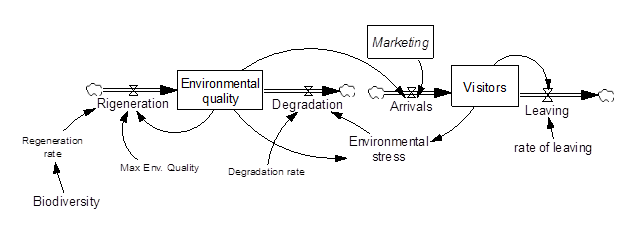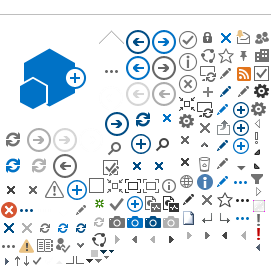Qualitative dynamic models for Natura 2000 site management
The flows of ecosystems services provided by Natura 2000 sites depend in a complex way on many variables related to ecological (chemical, physical, biological) and socioeconomic processes, which interact at different levels in the scales of time and space. It is not practical to understand the full complexity of these relationships, especially on the basis of the data usually available for these sites. However, a system dynamics (SD) approach makes it possible to distinguish major variables and their cause-effect relations, and to visualise their recurrent dynamics.
An assumption of system dynamics is that system behaviour emerges from its structure (cause-effect relationships + feedback loops) rather than from the values of single variables. Indeed, the aim of this approach is to understand the behaviour of complex systems in time, considering internal feedbacks and delays that influence the behaviour of the whole system. The approach is essentially qualitative, although it may include simulations based on differential equations, since even the results of numerical simulations are interpreted qualitatively. The typical question that can be answered by a SD model is: if A increases (e.g. due to natural causes or management), what happens to B or C over time? Or what management strategy is better: A or B?

Here we propose simplified models of the systems underlying the various ecosystem services. These models have various aims:
- to represent the main variables involved in site management and in the process of reproduction of the ecosystem service
- to understand and visualise any feedbacks between possible management measures and system variables
- to reveal any implicit assumptions that would be deleterious for the aims of enduring development and protection of biodiversity in Natura 2000 sites
- to sustain collaboration promoting convergence of ideas, knowledge, interests and positions, based on discussion between stakeholders
- to facilitate the definition of management problems and strategies from new, possibly intersectoral perspectives (e.g. tourism, landscape ecology, conservation of biodiversity)
- to provide managers with a body of knowledge on which to develop specific models for their sites and to simulate management scenarios.
In other words, the general aim is to sustain site management through improved understanding of the complex dynamics involved and the possible consequences of acting on the system.
Dynamics of environmental quality and visitors in scenarios with different marketing levels:

Dynamic models MGN in Insight Maker
Insight Maker is a general web-based tool for modeling and simulating. The following models are available:
Dynamic models MGN in Vensim
Vensim is a system dynamics modelling programme available in various versions. The free personal learning edition (PLE) sufficient for the present context can be downloaded at: http://vensim.com/free-download/.
Download the Manual 'Qualitative dynamic models'
Download Models Vensim LIFE+ MGN
